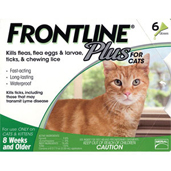Lyme disease is not as commonly diagnosed
in cats as it is in dogs, maybe because cats are so good at grooming
themselves and removing ticks before they have a chance to attach and
transmit the disease. But cat owners, particularly those that
live in the Lyme endemic regions of the northeastern U.S., northern
mid-Atlantic, upper Midwest and the northern California coast, should
still be aware of the disease.
It is important to note that although
people can develop Lyme disease, they cannot contract it directly from
cats or dogs; they must be bitten by an infected tick.
" An infected tick needs to be attached to a susceptible animal for at least 48 hours for transmission of the bacteria to occur."
What Are the Symptoms of Lyme Disease in Cats?
Infection with the bacteria Borrelia burgdorferi causes Lyme disease. These bacteria are transmitted
from one animal to another through the bites of particular types of
ticks (e.g., deer or Ixodes ticks). The ticks usually pick
up the bacteria from infected wildlife such as deer and rodents.
An infected tick needs to be attached to a susceptible animal for at
least 48 hours for transmission of the bacteria to occur.
Symptoms of Lyme disease in cats include:
- Painful joints and muscles.
Cats may limp, be reluctant to move, jump and climb, and can cry out
in pain when touched or picked up.
- Loss of appetite
- Low energy levels
- Fever
- The "bulls-eye" rash
that commonly affects people with Lyme disease is not frequently seen
in cats.
The ticks that carry Lyme disease are
very small, and symptoms can develop long after a cat has been bitten.
Therefore, even if you have not noticed ticks on your pet recently,
she may still have Lyme disease.
Lyme Disease Diagnosis and Treatment

Lyme disease is not the most common
cause of pain, fever and lethargy in cats, so your veterinarian will
need to run blood work that looks for exposure to Borrelia bacteria
and perform other diagnostic tests to rule out conditions that cause
similar symptoms.
If Lyme disease is diagnosed early
enough, a two or three week course of a certain type of antibiotic,
most often one called doxycycline, will usually lower bacterial numbers to the
point where cats no longer show any signs of the disease.
Preventing Tick Bites
The best way to protect your cat from
Lyme disease is to keep her indoors and use an effective tick control product like Frontline Plus. If you find a tick on your pet, remove
it promptly using a pair of tweezers or tick
pliers. Grasp the
tick as close to the skin as possible and pull it free, making sure
to remove the imbedded mouthparts as well. Flush the tick down
the toilet and wash your hands and equipment thoroughly.
The above is provided for information purposes only and should not be used for the diagnosis or treatment of any condition.
This information does not cover all possible variables, conditions, reactions, or risks relating to any topic, medication, or product and should not
be considered complete. Certain products or medications may have risks and you should always consult your local veterinarian concerning the treatment of
your pet. Any trademarks are the property of their respective owners.